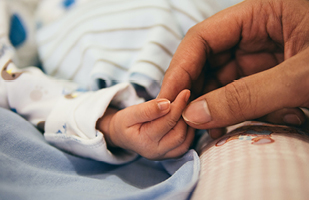Courts’ Reforms Target Child Safety, Family Unity

Three Ohio courts established wider reaches for child and family welfare against substance use with grants aimed to incorporate more community stakeholders.

Three Ohio courts established wider reaches for child and family welfare against substance use with grants aimed to incorporate more community stakeholders.
For decades, the legislative and judicial branches have worked together to address child abuse issues.
That collaborative effort reflects how Ohio communities are tackling these problems holistically, especially during National Child Abuse Prevention Month, which has been nationally observed every April since 1983.
Three juvenile and probate courts – in Coshocton County, Fairfield County, and Trumbull County – recently concluded three years of grant-funded programming centered on changing the ways local stakeholders handle issues of substance use in families with children, specifically those under age 3.
“It’s about changing the world one child at a time,” said Rick Tvaroch, the quality assurance administrator with Trumbull County Children Services.
Network Expansion to Monitor Children, Family Well-BeingThe National Quality Improvement Center of Collaborative Community Court Teams worked in tandem with the three courts’ family dependency specialized dockets to develop and implement new strategies to work with this challenging population..
The purpose was to increase the number of community agencies helping families struggling with substance issues and connect all of those partners for a unified, integrated approach to resolving such a complex problem.
Typically, the burden has fallen separately on local courts, children’s services agencies, and treatment providers – substance use and mental health – creating gaps in communication that prevent assistance or result in inefficiencies.
“We all want the same thing, but it often felt as we were working in silos,” said Trumbull County Family Treatment Court Coordinator Jodie Milhoan. “Now, we’re together. There’s a more unified focus.”
The funding came from the Center for Children and Family Futures, a nonprofit devoted to the intersections among child welfare, mental health, substance use disorder treatment, and court systems. Through practice, policy, and evaluation, it aims to help improve outcomes for children and families.
The organization has a strong working relationship with the Ohio Supreme Court through years of dialogue and efforts to enhance child and family welfare. That foundation established the group’s trust to fund the three Ohio juvenile and probate courts’ ambitions to reform their systems.
“It’s such an amazing time because there’s so many changes going on with child welfare, and trying to engage families to make better outcomes,” said Fairfield County Probate and Juvenile Court Magistrate Michelle Edgar.
Edgar, who oversees the specialty court known as the Excel Program, saw the project as a means to an overdue overhaul.
The first step was reformatting the court’s role for participant accountability. After unsuccessfully following an adult drug court model, the court shifted to an incentive-based approach to underline changes toward constructive behaviors and actions.
The importance of positive reinforcement extended to completely changing verbiage to more-informed terminology, such as referring to sobriety as recovery capital.
Another alteration was emphasizing personal growth aside from recovery, specifically parenting.
“We’re trying to change how the community is looking at a subset of parents that are a part of our community,” said Makaila Tussing, the specialized dockets coordinator for Fairfield County Probate and Juvenile Court.
Origins, Evolution of Child Welfare ImprovementThe impetus for this change stems from a national law put into place decades ago.
Enacted in 1974, the Child Abuse Prevention and Treatment Act provides financial assistance for programs applied to the prevention, identification, and treatment of child abuse and neglect.
Since then, the law has undergone multiple amendments to fill holes in coverage and to accommodate changing societal struggles.
The most recent reincarnation, the Comprehensive Addiction and Recovery Act, was implemented in 2016.
Some of the more commonly known results of that legislation were the widespread distribution of naloxone and drug takeback boxes, and more access to treatment facilities to combat the opioid epidemic.
The Collaborative Community Court Teams initiative was cultivated as part of this increased awareness for stakeholders to be more proactive by recognizing red flags earlier with a wider set of eyes.
Instead of only the judicial, child welfare, and treatment components, other groups are assisting with the detection of families in trouble and the implementation of wraparound services to build stability for all family members.
These partners include hospitals and health clinics that can identify pregnant mothers with substance use disorders, childhood development organizations that may suspect substance use within the home, and peer supporters who can empathize and encourage through the struggles of their shared experiences.
System to Limit Lapses, Future UpheavalThe collective approach to producing a support system for the family, specifically to the children, is known as a plan of safe care.
“One way to limit people from falling through the cracks is soft handoffs,” said Leondra Davis, the coordinator for Coshocton County’s family dependency court.
The collaborations forge a chain where partners work in tandem with participants. When the needed services extend beyond one group, the next organization is seamlessly there as the next link. It could be a legal matter with the courts or children’s services, or essential needs such as food, housing, and medical concerns.
The community backing has formed a web of support that shares the responsibility and eases the burden for all involved, including the families.
In protecting the children and helping parents with their respective issues, the goal is not only to stop the current conflicts, but to prevent even more trauma from the fallout of broken homes.
“They deserve to have us there. They deserve to be a family. They deserve for us to fight for them to have contact in the safest, healthiest way possible,” Tussing said.


